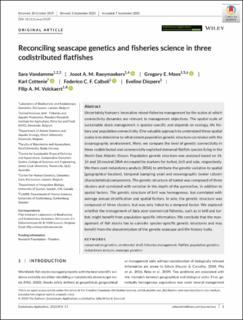| dc.contributor.author | Vandamme, Sara | |
| dc.contributor.author | Raeymaekers, Joost A. M. | |
| dc.contributor.author | Maes, Gregory E. | |
| dc.contributor.author | Cottenie, Karl | |
| dc.contributor.author | Calboli, Federico C. F. | |
| dc.contributor.author | Diopere, Eveline | |
| dc.contributor.author | Volckaert, Filip A. M. | |
| dc.date.accessioned | 2021-02-26T10:23:09Z | |
| dc.date.available | 2021-02-26T10:23:09Z | |
| dc.date.created | 2020-12-07T18:00:37Z | |
| dc.date.issued | 2020 | |
| dc.identifier.citation | Vandamme, S., Raeymaekers, J. A. M., Maes, G. E., Cottenie, K., Calboli, F. C. F., Diopere, E. & Volckaert, F. A. M. (2020). Reconciling seascape genetics and fisheries science in three codistributed flatfishes. Evolutionary Applications, 14(2), 536-552. doi: | en_US |
| dc.identifier.issn | 1752-4571 | |
| dc.identifier.uri | https://hdl.handle.net/11250/2730604 | |
| dc.description.abstract | Uncertainty hampers innovative mixed‐fisheries management by the scales at which connectivity dynamics are relevant to management objectives. The spatial scale of sustainable stock management is species‐specific and depends on ecology, life history and population connectivity. One valuable approach to understand these spatial scales is to determine to what extent population genetic structure correlates with the oceanographic environment. Here, we compare the level of genetic connectivity in three codistributed and commercially exploited demersal flatfish species living in the North East Atlantic Ocean. Population genetic structure was analysed based on 14, 14 and 10 neutral DNA microsatellite markers for turbot, brill and sole, respectively. We then used redundancy analysis (RDA) to attribute the genetic variation to spatial (geographical location), temporal (sampling year) and oceanographic (water column characteristics) components. The genetic structure of turbot was composed of three clusters and correlated with variation in the depth of the pycnocline, in addition to spatial factors. The genetic structure of brill was homogenous, but correlated with average annual stratification and spatial factors. In sole, the genetic structure was composed of three clusters, but was only linked to a temporal factor. We explored whether the management of data poor commercial fisheries, such as in brill and turbot, might benefit from population‐specific information. We conclude that the management of fish stocks has to consider species‐specific genetic structures and may benefit from the documentation of the genetic seascape and life‐history traits. | en_US |
| dc.language.iso | eng | en_US |
| dc.publisher | Wiley | en_US |
| dc.rights | Navngivelse 4.0 Internasjonal | * |
| dc.rights.uri | http://creativecommons.org/licenses/by/4.0/deed.no | * |
| dc.title | Reconciling seascape genetics and fisheries science in three codistributed flatfishes | en_US |
| dc.type | Peer reviewed | en_US |
| dc.type | Journal article | en_US |
| dc.description.version | publishedVersion | en_US |
| dc.rights.holder | © 2020 The Author(s) | en_US |
| dc.subject.nsi | VDP::Landbruks- og Fiskerifag: 900::Fiskerifag: 920 | en_US |
| dc.subject.nsi | VDP::Matematikk og Naturvitenskap: 400::Basale biofag: 470 | en_US |
| dc.source.pagenumber | 536-552 | en_US |
| dc.source.volume | 14 | en_US |
| dc.source.journal | Evolutionary Applications | en_US |
| dc.source.issue | 2 | en_US |
| dc.identifier.doi | 10.1111/eva.13139 | |
| dc.identifier.cristin | 1857176 | |
| dc.description.localcode | Unit Licence Agreement | en_US |

